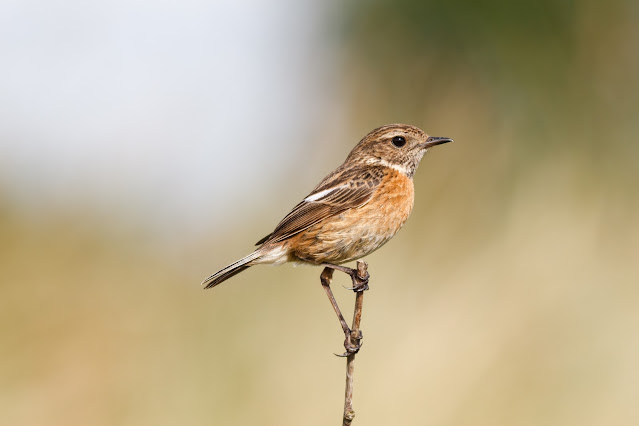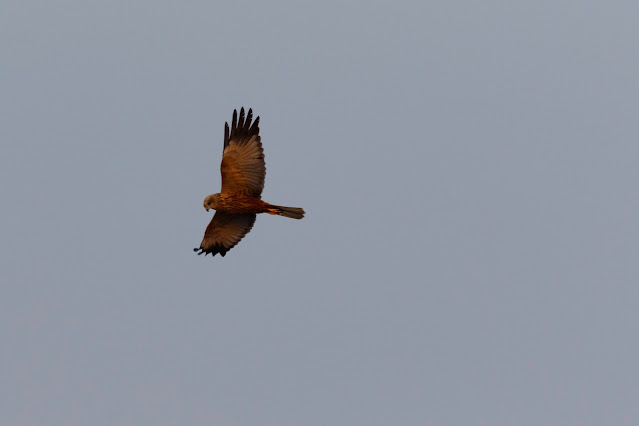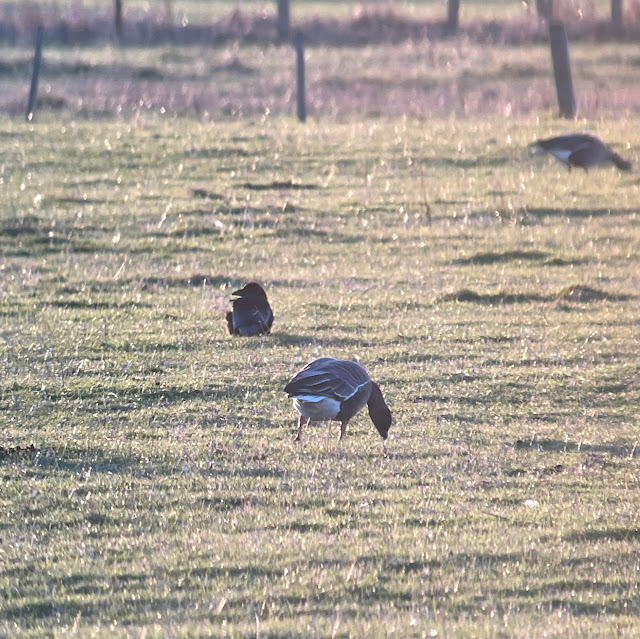The forecast didn't look too promising for this weekend and I felt like autumn was slipping away without a final finale. However, on Thursday things started to look better, with an easterly and some good seawatching. Instead of seawatching, I was sat in my office in zoom meetings all day.
Friday
As there looked to be a slim chance of a late migrant or two, I took a flyer on Friday afternoon and headed to the patch with Janet. We started with a look on the sea but it was quiet, a bonxie going south, only my second of the year, was the highlight. Not an auk in sight. Janet found a snow bunting on the beach which was a year-tick.
 |
| Female snow bunting in poor light |
 |
| Same bird, different pose |
We headed for the bushes, checking the area around the start of the path to the hides first. A female blackcap was a good start. I got onto a small bird flitting about in the branches, above the blackcap - I called 'yellow-browed warbler' to get Janet onto it, but it had flitted off. Even though I had the briefest views - Strong wing-bar and supercillium, pale tips to darker secondary feathers, it wasn't right for a yellow-brow. It was duller than a yellow-browed, almost with a grey cast. Hume's warbler sprang to mind but I needed better views to be sure and Janet needed to see it. I put the news out as 'a probable'.
We didn't have to wait long, as the bird re-appeared to the right and gave tantalizingly brief views as it flitted quickly through the branches. It had a colder, greyer look to it than a YBW, the wing bar and the supercilium were more off-white without yellow tones and the bill and legs appeared to be dark. It hadn't called at this stage, but we were both confident that it was Hume's and put the news out.
A 'bird wave' of tits and goldcrests came through, which also brought a willow tit and chiffchaff to the party. We lost the warbler in the melee, when we refound it, it was further right and it flew and called - a short, sharp two-tone call, not like yellow-browed's more drawn out 'twoo-eeee'. It did this twice before flying off south.
We suspected it might have gone south with the tit flock, so I headed down towards the Budge hide but couldn't relocate it. Two ruff were on the fields and water rails were calling. We couldn't relocate the warbler by dusk so headed home. I would be back in the morning.
I had a likely Hume's warbler many years ago by the Budge hide. It's in a long-lost notebook and was never submitted, so technically not a new bird for the patch. I've seen three others in the county, at Whitley Bay (2006), Lynemouth Power Station (2002) and East Chevington (2001).
 |
| Robin - ever-present and singing a mournful autumn tune |
Saturday
I got down to the patch at about 9.30. A handful of birders including Ashington Gary and Paul from Gateshead were loitering on the path but had not seen the bird, I headed north for a look through bushes. Two female long-tailed ducks were on Druridge Pool. With no further sign, I headed south to the Budge hide and checked the bushes there. It was quiet, so I checked the Budge fields and picked up a water pipit on call, which I eventually found feeding on wet grassland to the left of the hide. Bonus!
I wandered north through the bushes, when a tit flock came through and I picked up a firecrest amongst them. Nice. This was my third of the year on the patch! The flock headed south, so I followed them. I called ADMc as I know he likes a firecrest. Andy, Paul, Bob and Steve arrived - the bird was tricky to pin down, but they all got onto it eventually.
 |
| Not sure this photo will make the Annual Report. |
Whilst scanning for the firecrest, I found yesterday's Hume's warbler in a big willow. It was really tough to get people on it before it flew north over the path with some long-tailed tits. I found it again in a lower willow but it was lost to view after that and not seen again. I'm not sure how many people saw it - So frustrating!
A treecreeper was added to the day list - a scarce species on the patch.
I think that might be autumn over...












































